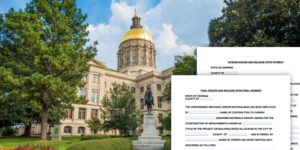
After sitting on Governor Brian Kemp’s desk for over a month now, Senate Bill 315 aimed at amending the laws governing Georgia’s lien waiver rules have finally been enacted. This bill represents a huge win for contractors, subs, and suppliers operating in the state of Georgia. It will make significant changes to the lien waiver process that will help protect contractors and suppliers retain their rights to recover the money they’ve earned. Here’s everything you need to know about the Georgia lien waiver changes set to go into effect in 2021.
Georgia’s existing lien waiver rules
The rules governing lien waivers in Georgia are unique, for lack of a better term. They require anyone who executes a waiver to pay close attention to timelines, and act quickly if payment never comes.
Georgia lien waivers are essentially both conditional and unconditional. Basically, once a waiver has been signed, they conditionally waive lien rights until payment has been received. But there’s a catch.
If you aren’t paid within a period of 60 days after the waiver is executed, the claimant will need to either file an Affidavit of Nonpayment, or file a lien claim. If neither of these two actions are taken, the waiver will then convert to an unconditional one. This means that your lien rights are waived, whether or not you’ve been paid.
For a full breakdown of the Georgia lien waiver requirements, see: Georgia’s Very Unusual Rules for Mechanics Lien Waivers.
Although this seems confusing, once you’ve gotten into the habit of following up with your lien waivers, it’s fairly straightforward. But the language on the waiver is tricky, and can cost some contractors more than just lien rights, as you’ll see below.
The Ultimate Guide to Lien Waivers in the Construction Industry
The path to Georgia lien waiver reform
With Governor Kemp’s signature, the waiver process received some well-needed clarification. Well, at least once these Georgia lien waiver changes go into effect on January 1, 2021.
But how did we get here? What sparked this reform?
To quote the Spanish philosopher George Santayana, “To know your future you must know your past.”
The Georgia case that broke the lien waiver’s back
It all starts with a Georgia Court of Appeals case that was decided back in September of 2019. Here’s what Richard Storrs, a Georgia construction attorney of Storrs Law Firm in Atlanta, had to say about the case:
In ALA Construction Services, LLC v. Controlled Access, Inc., the Court of Appeals found that the unambiguous language of the mechanic’s lien statute provided that a lien waiver is binding for “all purposes”, and this meant that the waiver barred an underlying contract claim, not just a lien or bond claim. This interpretation adversely affected claimants who signed a lien waiver, were not paid the consideration, and failed to file a claim of lien or affidavit of nonpayment within 60 days. Under the statute and waiver form, the consideration was “conclusively deemed to have been paid,” even if payment had not been made.
The Court of Appeals focused on the language stating that the waiver is binding “for all purposes” and ignored the waiver language that connected the waiver to lien and bond rights only, not contract remedies. The ruling also ignored the purpose of the statute.
Fortunately, legislators and Governor Kemp provided clarification and protection so that contract rights aren’t needlessly curtailed.
You can read a full review of this case here.
Bill was swiftly introduced to make changes to the lien waiver process
That case was decided in September of 2019. The decision was controversial at best, and was met with some strong responses. Many in the construction industry found it unbelievable that a lien waiver could waive all other recovery options, even those unrelated to mechanics lien rights.
A few short months later, Senate Bill 315 was introduced as a direct response. The state legislature moved quickly to get this bill introduced and passed nearly unanimously through both the House and the Senate.
We reported on this bill when it was first introduced: Georgia Lien Waiver Bill Aims to Limit Fallout from Court Decision.
Overview of Georgia lien waiver changes
Now that we know how these changes came about, let’s break down the actual scope of these changes. The bill will make some drastic changes to OCGA §44-14-366 governing lien waivers and the Affidavit of Nonpayment.
Waivers limited to mechanics lien and bond claim rights
The very first subsection of the statute will now read:
“Waivers and releases provided for under this Code section shall be limited to waivers and releases of lien and labor or material bond rights and shall not be deemed to affect any other rights or remedies of the claimant.” (Emphasis ours.)
Consistent with this addition, the language of the waiver forms themselves have also changed. First and foremost, instead of being titled “Waiver and Release Upon Payment” it will now be called “Waiver and Release of Lien and Payment Bond Rights Upon Payment.”
Furthermore, the notice language at the bottom will no longer state that the claimant has been paid in full. That statement has been replaced with “waived and released any and all liens and claims of liens upon the foregoing described property and any rights regarding any labor or material bond regarding the said property to the extent (and only to the extent set forth above).”
Affidavit of nonpayment changes
Similar to the current statute, and lien waiver will convert from a conditional to an unconditional waiver if the claimant doesn’t take action. However, there are some important changes to this process.
First, instead of 60 days to act, the party executing the waiver will have 90 days to prevent this conversion. Second, a claimant is now only required to file their affidavit of nonpayment. Filing a mechanics lien within the required timeframe is no longer an option.
This takes any guesswork and tough decisions out of the mix. The Affidavit of Nonpayment will now be the exclusive method of preventing your lien waiver from becoming unconditional.
Lastly, the language of the affidavit will now take into account partial payments. Under the current form, the affidavit states that “the amount set forth in said waiver and release… has not been paid.” On the new affidavit, it will now read “”has not been paid in full and $___ of the amount set forth in said waiver and release remains unpaid.” (emphasis added)
Other minor changes
These are some other minor changes made to the statute. They may seem trivial, but mechanics lien statutes have been historically interpreted and enforced strictly, so even minor changes can have a significant impact.
- Waivers and Affidavits of Nonpayment no longer have to be in boldface type, nor do they have to be in all capital letters.
- When referring to the Georgia statutes, the word “Section” will be replaced with “§”
- 90 days must replace the “60 days” set forth on the lien waiver form
- Regarding the new procedure to prevent unconditional status, the waiver should no longer contain the term “either” and “or claim of lien” as options.
Keep following GA waiver procedures carefully until 2021
This is huge news for Georgia contractors. But, don’t get too ahead of yourselves yet. As we mentioned above, these Georgia lien waiver changes don’t go into effect until January of 2021. In the meantime, the proper use of waivers and affidavits of non-payment cannot be stressed enough.
Anytime you execute a waiver in Georgia, be sure to mark your calendar. If the Affidavit of Nonpayment isn’t submitted or a lien claim isn’t filed within 60 days after every lien waiver, you may find yourself with little recourse when trying to recover payment.


